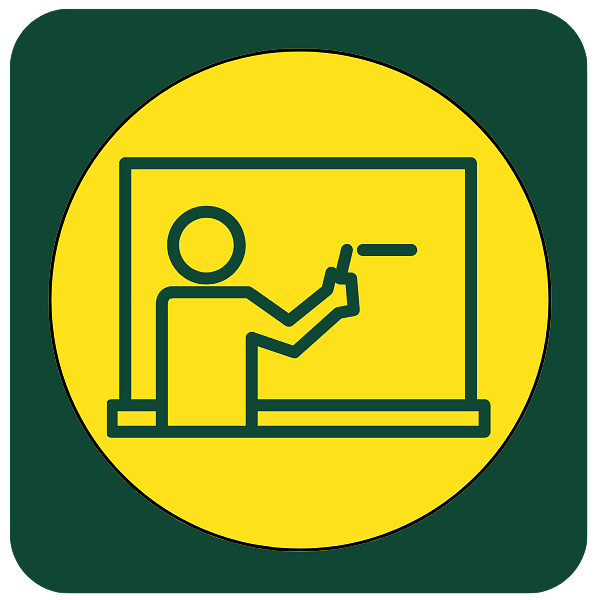Preparing to Teach Online Toolkit
This Toolkit is intended to support all faculty teaching online classes at UO and is particularly important for faculty who are new to teaching online. Continue reading to learn how Regular and Substantive Interaction (RSI), a federally mandated requirement for prioritizing engagement as a fundamental learning strategy in online courses, can be effectively done. This Toolkit also examines the Community of Inquiry framework (CoI) as a way for faculty to cultivate teaching, social, and cognitive presences in online courses. Both resources support meaningful practices faculty can develop in online and hybrid courses to encourage students to become critical thinkers in their classes and beyond.
The information here forms the basis of UO Online’s Preparing to Teach Online workshop. We offer this workshop each term to help instructors who will be teaching online for the first time fulfill the UO policy requirements for online courses (hybrid, asynchronous online, and synchronous online). Search for upcoming Preparing to Teach Online workshops on the events page of teaching.uoregon.edu.
Regular and Substantive Interactions
Ensuring Regular and Substantive Interactions
Online students flourish when instructors engage with them in regular and meaningful ways. In fact, U.S. Department of Education regulations name “regular and substantive interaction” as an essential criterion for online courses. It can be challenging to build these learning partnerships in online and hybrid classes, but meaningful interactions can help our students become critical thinkers in our classes and beyond. This guide explores what it means when regular and substantive interactions guide student learning in your online class.
The U.S. Department of Education approved new regulations in 2021 for online courses and programs for which students may use federal financial aid. At UO, this would include web synchronous, web asynchronous, and hybrid instructional classes. The regulations state that these classes must ensure "regular and substantive interactions (RSI) between a student and an instructor(s)."

"Regular" is defined as taking place on a "predictable and scheduled basis" throughout the course.
"Substantive" means engaging students in the class through teaching, learning, and assessments including at least two of the following instructional activities:
- Providing direct instruction
- Assessing or providing feedback on a student's course work
- Providing information or responding to student questions about the content of the course or competency
- Facilitating a group discussion regarding the content of a course or competency
- Or other instructional activities approved by the institution's/program's accrediting agency.
Without face-to-face lectures, online instructors must be more intentional about creating opportunities for regular and substantive interaction to occur. Interactions should be designed to offer value to the student experience and positively affect learning outcomes.
You don't have to rely on only two or three strategies - you can "mix and match" how you engage students throughout the course based on student needs.
- Examples to Explore (click to expand)
Providing direct instruction can include video lectures if students are required to watch and then interact with you (the instructor). Consider framing your lecture videos with questions for students to consider as they watch, or asking them to identify specific themes or concepts from the video in a follow-up survey or discussion post.
Assessing or providing feedback on a student's course work can be done both on an individual student basis and by identifying trends in student responses and sending a clarifying message to all students or to student groups.
Providing information or responding to student questions can be accomplished via a class Q&A discussion board related to lectures, readings, and other course instructional content. Be sure to check regularly for student questions and let students know how often/when you'll be reviewing the forum.
Facilitating group discussions doesn't mean you must post responses to every discussion topic, but you should select times during the class when your guidance would be most useful. Focus on both good and intriguing points as well as providing clarification as needed.
Or other instructional activities approved by the institution's/programs accrediting agency might include specific activities you engage students in for research or program development.
- What Current Online Instructors Wish They'd Known Earlier (click to expand)
- You must be explicit in your instructions for activities since students can't ask questions in the moment as in an in-person class.
- Think about a student beginning an assignment at 9pm on Saturday: Where will they get assistance? What kinds of questions might they run into and how can they be self-sufficient and get the task done? Consider using the Transparent Assignment Design format (Purpose, Tasks, Criteria for Success) for your assignments.
- A lot of intention and front-loading work must be done in online course design to anticipate and allow for engagement opportunities that can meet a diverse range of asynchronous student needs. That work requires thinking ahead about how to frame opportunities for engagement, which helps to counteract a "set it and forget it" design mindset.
- You must be explicit in your instructions for activities since students can't ask questions in the moment as in an in-person class.
To be considered as RSI, interactions must be:
- Initiated by the Instructor
- Frequent and Consistent
- Focused on Course Content
What is NOT considered RSI?
- Recorded content or readings that do not require review of the material and then interaction with the instructor
- Instructor-student contact not related to course content
- Recording grades
- Auto-graded assignments
- Welcome or reminder messages
- Unmoderated online forums
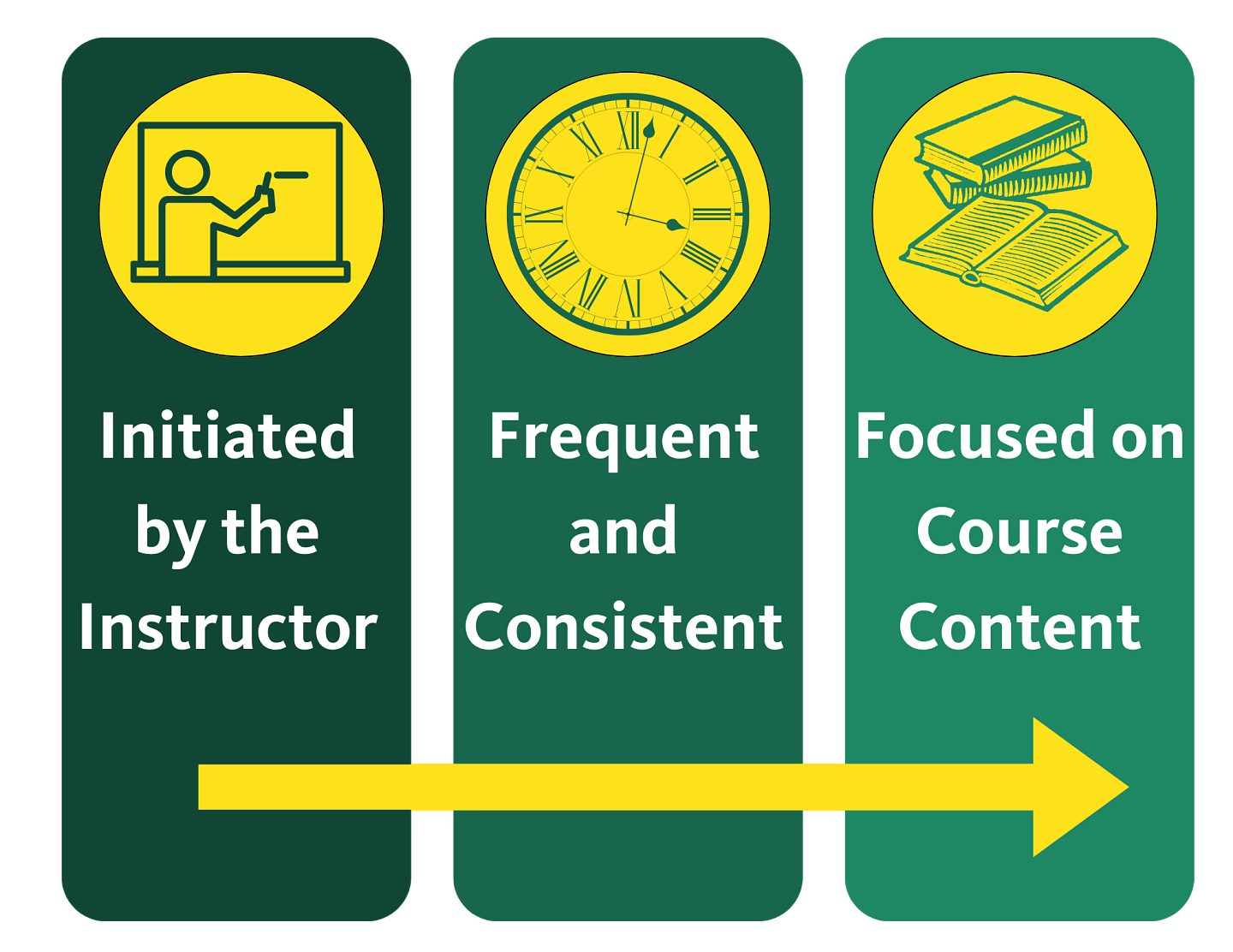
Initiated by the Instructor
Interactions with students that constitute regular and substantive need to be initiated by you, the instructor. It's important that you are present in the course with students, guiding a range of interactions with them throughout the course. This ensures that these interactions are not optional. Instead, they are an integral part of the course design.
- Initiated by the Instructor (click to expand)
Communication with Students
- Individualized emails
- For example, emailing students who have not logged into the Canvas course site at the beginning of the term and messaging students who have missed assignments later in the term.
- Instructor-facilitated discussions
- Consider periodic discussion forums asking students to apply what they are learning to their personal life experiences.
- Scheduled virtual office hours
- Instructor-facilitated annotated readings
- Student surveys at mid-term, after a major project, or at the end of the term encourage student reflection that can help you make necessary adjustments
- Announcements about course content or assignments posted on a regular schedule
- Consider scheduling announcements on a specific day and time and communicate that in your syllabus or welcome message.
Directing student learning
- Personalized and targeted feedback on assignments. Consider using audio or video feedback as well as written feedback.
- Feedback should be meaningful, both to validate good student work and to suggest work that could be improved.
- Posting discussion questions and actively monitoring the discussion, clarifying or redirecting as needed. Consider using Hypothesis or Perusall for discussions and actively engage with students.
- Inviting a student to visit you during office hours to discuss their overall progress or providing feedback on a specific course activity.
- Providing alternative office hours near mid-term or finals to encourage students who might not be able to visit regular office hours otherwise.
- Individualized emails
- Instructor Initiated Interactions - Questions for Consideration (click to expand)
The Human Element
- Are you reaching out to all students at least once during the course? This can be individually or through small group feedback.
- Are you messaging students who may need personalized help? Doing so during high-impact moments like near mid-term or after important assignments is most effective.
- Are you establishing a regular, predictable rhythm with your announcements and feedback timelines?
Frequent and Consistent
Interactions with students should be regular, scheduled, and predictable. Once a class starts, long intervals of time shouldn't pass between the interactions you initiate with students.
The type of interaction may vary throughout the term depending on student needs, but the regular cadence of interactions you set should remain as consistent as possible.
- Simple Steps for Frequent and Consistent Interactions (click to expand)
Frequent
- Set a pattern early on with your students regarding when they can expect feedback on assignments.
- Establish a schedule of announcements so students know when to look for new content and/or feedback.
Consistent
- Let students know when they can expect to have feedback on assignments and projects in your syllabus and in your welcome message.
- For example, "Assignments are due Sunday night by 9pm. I will begin grading your work on Monday and all feedback and grades will be posted by Wednesday evening at 6pm."
- Let students know when you'll be sending out weekly overview announcements or updating your home page.
- Be sure to let students know in advance if there will be any change in your set announcement schedule.
- Let students know if there are periods of time when you will not be able to respond to messages.
- For example, if you do not respond to emails on the weekend, let students know at the beginning of the term and remind them, if necessary, during the term.
- Frequent and Consistent Interactions - Questions for Consideration (click to expand)
- Do students know when to expect feedback and what to do if they have questions about their grades?
- Do students know when there may be a delay in your responses to email messages?
- Have you posted your office hours in a way that students can find them quickly?
Focused on Course Content
It's always great when faculty and students connect on subjects outside of the specific course or class. However, to be considered RSI, interactions with students should be focused on course content and their progress towards course goals and learning objectives.
- Simple Steps for Focusing on Course Content (click to expand)
Post Announcements Strategically
- Post examples of how a real world situation relates to course content.
- Consider weekly announcements that introduce that week's concepts and how they connect with previous content.
Engage Students with Discussions
- Invite students to post their own real world experiences with assigned content in a discussion forum.
- Collect responses to discussion posts with a digest that addresses trends, extends applications students made to course content, and connects work explored in discussions to other activities and assignments.
- For large enrollment classes, consider dividing discussion forums into groups, assigning roles for group members to take on to deepen discussion.
Provide Assignment Guidance
- Post examples of how current events relate to assigned content. Provide a Q&A or "Ask a Question" forum for student-to-student questions about assignment expectations.
- Monitor this forum regularly to reinforce ideas and provide any necessary clarifications or redirection.
- Consider preparing a "student details" document at the start of the term to document any student learning styles, research interests, or concerns students share with you through a "get to know you" survey. Reference relevant details as part of your evaluative feedback.
- Focused on Course Content - Questions for Consideration (click to expand)
- Where are there opportunities to connect what students are learning in your class to current events throughout the course?
- Are there places in the course where you can invite student experience that connects with content?
Community of Inquiry Framework
Creating a Community of Inquiry in Online Classes
An educational community of inquiry is a group of people who work together to develop personal meaning and reinforce mutual understanding via critical dialogue and reflection. Creating a community of inquiry in your online courses can lead to highly engaging and meaningful learning experiences. In the sections below, we explore the three interconnected facets of the Community of Inquiry (COI) model – Social, Cognitive, and Teaching Presence – then provide resources and guiding questions to help you utilize COI within your own courses.
The Community of Inquiry model is a theoretical framework created by Garrison, Anderson, and Archer, (2000) that represents the process of creating deep and meaningful learning experiences through the development of three interdependent elements: Social, Cognitive, and Teaching Presences. Multiple studies have shown a link between the three presences and students' perceived learning, course satisfaction, instructor satisfaction, actual learning, and sense of belonging (Akyol & Garrison, 2008; Arbaugh, 2008; Kucuk & Richardson, 2019). This framework is not a static model; rather, it is meant to be explored as a dynamic process. All of the presences are described with several intersecting dimensions. The resulting categories operationalize each of the presences. Design, facilitation, and direct instruction are all facets of Teaching Presence. Affective, interactive, and cohesive expression by learners are all indicators of Social Presence. Cognitive Presence consists of four phases: a triggering event, exploration, integration, and resolution, which mirror the critical thinking process.
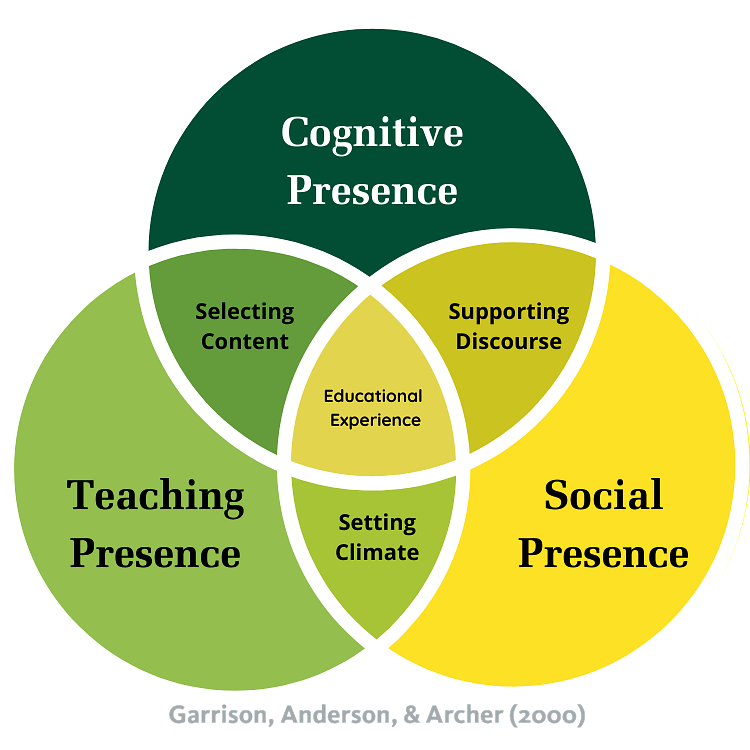
Operational Definitions of COI Presences
| ELEMENTS | CATEGORIES | INSTRUCTOR ROLE |
|---|---|---|
| Teaching Presence |
|
|
| Social Presence |
|
|
| Cognitive Presence |
|
|
(Table adapted from Akyol & Garrison, 2008)
Teaching Presence
Teaching Presence is that unique and personal element that you bring to a course, which helps build a deeper connection with your learners. In face-to-face courses, this tends to occur more naturally through physical presence and teacher immediacy. Teaching Presence can be difficult to curate no matter the modality. After all, it can take years to feel comfortable with the performative aspect of teaching or sharing parts of our true selves with our students. But many of us are less experienced with these challenges in an asynchronous format where we cannot share space with our students. In online education, Teaching Presence is dependent on course design and organization, facilitation of online dialogue, and well-focused direct instruction. Teaching Presence intersects with Social Presence in how you share your passion and personality, and how you convey personal meaning within the course material.
There are many simple ways to create a Teaching Presence that is true to your subject and your authentic self. Below you’ll find guiding questions and useful tools to help you plan for and create Teaching Presence within your own courses.
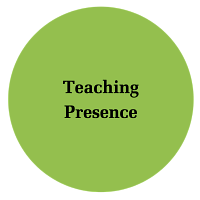
- Simple Steps Toward Achieving Teaching Presence (click to expand)
Be Present & Authentic
- Make an introduction video to let students know who you are.
- Videos do not have to be perfect: a few stumbles and "ums" show that you're human.
- Model engagement in discussions thoughtfully and with respect.
- Let your passion for the subject shine through in all your course interactions.
Be Organized
- Make sure your course is easy to navigate.
- Be certain that all assignment instructions are clear.
- Organize modules, readings, and resources in ways that scaffold the learning of complex concepts.
Help Make Connections
- Locate points of confusion or major concepts that need to be reiterated and address clarifications to the class as a whole.
- Find places to help learners connect the material to their own lives.
- Use discussions/assignments to connect students to each other, to the content, and to you.
- Make an introduction video to let students know who you are.
- Teaching Presence in Your Courses - Questions for Consideration (click to expand)
The Human Element
- Do you introduce yourself to the students?
- Does your personality come through in your course?
- How do you exhibit your passion for the course and/or the subject?
- Do you display how the course content has personal meaning or connections for you?
- Do you model the skills you expect from your students with both interactions and analysis?
Course Design & Organization
- Is your course design intuitive and consistent?
- Is it easy to navigate?
- Are all activity instructions clear, explicit, and concise?
- Is your feedback timely and supportive?
- Do students know how to contact you with time-sensitive questions?
- Do you curate your course effectively by selecting and arranging readings, videos, and other resources to scaffold concepts?
Facilitation
- Do students know how they are expected to participate?
- How and when do you contribute to the conversation?
- Do you use students’ names when you respond to them?
- Do you post announcements, discussions, and other feedback that aggregate student discoveries and ideas as common patterns?
- Interview with UO's David McCormick: Teaching Presence in Online Courses (click to expand)
- Video Transcript (click to expand)
Video Transcript: Teaching Presence in Online Classes – with David McCormick and Sasha
Welcome to this video on teaching presence in online courses, where we showcase one instructor's strategies for designing, organizing and facilitating his course, in order to engage students in the learning - by creating a sense of connection and community. Teaching Presence is one facet of the Community of Inquiry Model, a theoretical framework created by Garrison, Anderson and Archer that represents the process of creating deep and meaningful learning experiences, through the development of three interdependent elements: Social, Cognitive, and Teaching Presence. Teaching Presence is that unique and personal element that you bring to the course, which helps build a deeper connection with your learners. In face-to-face courses, this occurs naturally through physical presence and teacher immediacy. In online education, however, this presence is dependent on course design and organization, facilitation of online dialog, well-focused direct instruction, and how you convey your passion and personality.
There are many simple ways to create teaching presence. Today, we are going to give you a peek inside a UO course that has a strong and singular teaching presence. We interviewed David McCormick, the faculty member who created this course, and talk about ways that you can create your own unique teaching presence that is true to your subject and your authentic self. Without further ado, let's meet David and his beloved colleague, Sasha.
My name is David McCormick. I'm the Director of the Institute of Neuroscience here at the University of Oregon. And this is Sasha, my sidekick. She's a Samoyed. She's nine years old. She's been with me for the eight of those nine years. Yeah, we're we're very much a part of the University of Oregon now. I'm also a faculty fellow at the Unthank Hall and we're often over there. So, if you ever see us around, just stop and say hello.
Tell us about your course.
I teach Biology 170, which is a class on happiness. Actually, it's called Happiness: A Neuroscience and Psychology Perspective. It's taught both in-person and online. I created this course to teach students life skills and positive life engagement.
When I was thinking about the material that I was going to present on life skills and happiness, I realized that I needed a kind of a unique teaching style. And I looked around a little bit and I came across one called Head-Heart-Hands. And the Head, Heart, Hands Model is simply intellectual learning, emotional development, and putting things into action/doing. And that's exactly how the course is designed. There's the, you know, facts and figures parts of the material... there is trying to engage the students in an emotional way... and you can do that by getting them to relate to their personal experiences by having them watch videos that draw out the emotional aspects of life engagement and so on. And then the action part is activities where, every week, we have the students do activities to put the lessons into practice.
How does Sasha fit into the course?
Well, you know, the Head, Heart, Hands Model is, as I said, intellectual, emotional, and action. So, I realized that I should develop a style that was conducive to, you know, a sense of life skills, well-being and putting into practice the things I was talking about in class. So, I thought, "well, how can I do that?" And one of those was... dogs. Everybody has... well, not everybody, but a lot of people have dogs. A lot of students have dogs. They miss their dogs. And from my practice of walking around campus with Sasha, I realized that it's kind of an immediate connection to that personal aspects of life, you know? Having a dog... petting a dog... And also an immediate connection to the emotional part. You know, a dog kind of brings out the the softness in us, the connection and the ability to be vulnerable, if you will. And so I thought, well, if I bring Sasha into the course, both in-person and online, that that would really help me make that connection to people.
Why did you choose to teach the course online?
With online teaching, you can reach students that you couldn't reach in person. I have a lot of students that couldn't come to campus - maybe they became ill or someone in their family became ill or they had to take a trip, or maybe they just want to do distance learning. Those students I could reach with the material. It made it very nice to have the course both online and in person, because there's a lot of flexibility there that I never appreciated. So, when students in person all of a sudden had an emergency or became ill - maybe they got COVID - they could just watch the lectures online and do the online version. So, I found it actually very beneficial to have the online version of the course as well as the in-person.
Why did you choose to include your outdoor activities in your lecture videos?
You know, one of the big problems with an online course versus an in-person course is having some type of way to relate to the students because you're just talking to your computer or you talking to a camera. And so, the dog helps, really. But I also wanted to exhibit both positive life skills and get the students to relate to me. So, all I did was just... wherever I went in Oregon: snowshoeing, hiking, biking, visiting a vineyard or the Oregon Raptor Center... I would just pull out my phone and interview someone. "Hey, what makes you happy?" Or I would just talk about the location I was at and film it. I keep it short, you know, to keep it kind of TikTok-video-like, you know, just a couple of minutes to kind of entertain the students for a little bit before we get into the content of the lecture. I really felt that that was a way to make a connection with the students even though they're watching a video. They're used to watching videos like TikTok's, Instagram Snippets, YouTube and so on. So, I tried to make something interesting for them to kind of engage them in the material first.
How do you film your videos?
Well, when we did the videos around different parts of Oregon, sometimes I did it by myself just with my phone and propped it up somewhere and held it. But often my wife was helping me out. And, you know, just using basic photography methods, keep the phone very steady, move it very slowly, keep everything centered well and maybe do a couple of different takes so that if one didn't work, the other one did. Yeah. And then when I'm making a lecture video, I was usually by myself, with Sasha by my side sometimes... usually, or in the background, like, for example, on my picnic table in my backyard was done by using my MacBook Pro. It has a very good high-resolution camera on it, and I used a podcast microphone, a Yeti, and I might use an Astro Pad, which allows your iPad to be a drawing device. I set those up on my picnic table... it would take, you know once you're used to it, only a few minutes to set it up.
What feedback have you received from students about the course?
I.. ah [laugh].. yeah, they love it..the course... and they say more, more, more. You know, "why don't we have more courses like this?" The course started out about 80 students, then it went to one hundred and thirty students in the next term, the next year. It's gone to two hundred and seventy students. The next year I am opening up to five hundred students. It's gotten.. and it's got 100 percent approval rating.
There's almost no student that says they don't highly recommend this course to another student. And I asked them, "Why do they like this course so much?" A) They like the content. They said that, you know, this is something I can actually use. I can use these life skills throughout my life. B) They like the design of the course. They like that it's engaging. It's at an open level that they can easily participate in. They love Sasha being in the videos. It helps them relate. They love the level at which I converse with them. I'm not talking down to them. I'm talking even with them, like person to person. And they love that. They love that their input is appreciated and desired. They have a chance to influence the course of the course. You know, I ask a lot of questions like "What things do we not cover that you would like to cover?" And I've learned that a conversation with them, even in a larger class where they feel like they have the opportunity to be individually heard and appreciated, which they do in my course, because we give a lot of individual attention when they want, it really helps them absorb the material and appreciate it.
Can you walk us through the structure of the course and how you designed it?
So basically, the course is designed in modules, there's 17 modules, and each module has multiple components. One of the components is the lectures. So, the [in-person] lectures are an hour and 20 minutes long because they're based on real life lecture classes. So, you can't watch an hour and 20 minute video, it's just too, too long, need breaks. So, I broke those into three or four segments of like 20 minutes each. And when I when I put in a real life element like…you could go to this place for a hike or you can go here for a bike ride... I did that only at the beginning of the set of lectures, so at the beginning of the module, and that was because I didn't want it to be... I wanted it to be a special treat to watch something outside the classroom as opposed to something that was happening all the time. It was just... 'Hey, let's.. we're getting started today on this topic... but first, here's an interesting place you could visit in Oregon or interesting thing you could do that's relevant in some way to the material.'
What advice would you give to other instructors about developing Teaching Presence in an online course?
Well, you know...I learned it actually in courses in-person, but I tried to extend it to online learning, which is that the students pick up on your vibe. They pick up on your enthusiasm for the material and how clearly you relate and present the material. So, students are drawn to an engaged, enthusiastic, interesting story, right? It's all about storytelling. So, if you can make your lecture, your 20-minute lecture or something, a story...you tell them where you're gonna go, tell them the material, tell them where you've been in this storyline that you're clearly very interested in and engaged about, I think it makes the the whole experience a lot better for the students.
Do you have any advice for instructors new to recording videos?
Yeah. I think that, you know, being present yourself, being enthusiastic, as I just said, be enthusiastic about the material, being engaged with the material both intellectually and emotionally, being invested in the material and conveying that, is the top thing you should do. You know, throwing in something about your personal life, how you relate to the material. You know, showing the students...let them see some of your your situation, maybe your yard or where you sit and read for classes or for your research or whatever, or your home office. You know, mix it up a little bit. I think interjecting some kind of relatedness of yourself to to the students can really help the coursework and the lectures to be interesting. Yeah. The best way to do that, I think, is to be really comfortable with the online presence. And so, I would say that... make a surrounding that's comfortable to you. I use my outdoor patio or my office at home because I'm very comfortable in those locations. Maybe do some deep breathing or some relaxation before you make the video. Maybe you could practice the video. You could do it a couple of times and then watch yourself and then realize it's not so scary. And another idea is to have someone on the other side of the computer that you're talking to. Like, it could be a student that's helping you out make the videos until you get really practiced at it, or it could be your spouse or significant other. So, make it a human element as opposed to just you talking to a machine. I think that bringing in that human element, that kind of vulnerability, that availability, really can help the students relate to you as a person and you as a teacher.
Thank you, David and Sasha.
We hope you enjoyed this video on teaching presence in online courses. For more information on the other two facets of the Community of Inquiry Model - Social and Cognitive Presence - Visit teaching.uoregon.edu/COI.
Blooper Reel:
[jaunty music]
I'm trying to get some of this.... [removes dog hair from sweater] Can you give me a kiss? Thank you. Okay, yeah [laughs] [grunts] Okay, there you go. Where you gonna settle, huh? [Sasha barks] You gotta be quiet, okay? I know...that's the thing... [removes dog hair from sweater] You holding my hand? [Sasha puts paw up on David’s arm] Thank you. Can you say 'thank you,' Sasha? Yeah? Okay? [Sasha licks David] Good [laughing]
Social Presence
Simply put, Social Presence is how students connect and interact with each other in a course. As Boston and colleagues (2010) define it, “social presence is the basis of collaborative learning and the foundation for meaningful, constructivist learning online. In the context of online learning, social presence is described as the ability of learners to project themselves socially and emotionally as well as their ability to perceive other learners as ‘real people’.” This idea can be particularly challenging in online courses, as we miss out on the immediacy and social cues that we get in-person. However, there are many ways to encourage and grow Social Presence in asynchronous courses.
Garrison and his colleagues (Garrison et al, 2000, 2007, 2010) developed three categories of Social Presence and continued to refine these categories over time. We will utilize these categories to provide suggestions and guidance below. The categories of Social Presence are:
- Affective responses (originally emotional expression);
- Interactive responses (originally open communication);
- Cohesive responses (originally group cohesion).
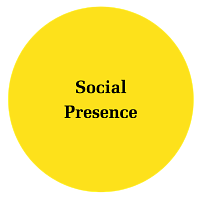
- Simple Steps Toward Achieving Social Presence (click to expand)
Affective Responses
“Affective expression is the ability of online learners to project themselves through such text-based verbal behaviors as the use of para-language, self-disclosure, humor, and other expressions of emotion and values” (Boston et al, 2010).
- Encourage connections from the start with an "introductions" discussion forum
- Consider using an icebreaker to launch conversation
- Try including a short course- or subject-related prompt
- For example, "Tell us about why this course interests you" or "Share which of the course objectives you find most intriguing and why"
- Encourage students to update their Canvas profiles with a bio, photo, and/or representative image or avatar
- Encourage the use of video, audio, or other media formats
- Make opportunities for different social connections, and bridge them into content if feasible
- Host a "Weekend Plans," "Pets of CLASS123," or "Fun Things" discussion board
- Provide a place where students can chat about their struggles in the course or greater program
- Build motivation and engagement
- Share your own passion and enthusiasm for the course
- Demonstrate how this course will be useful in students' lives or within the program
- Make content relevant and provide students choice in how they apply material
- Have students reflect on their own participation (mid-term, after a big assignment, at course end)
Interactive Responses
Help to create a "risk-free learning climate in which participants trust one another enough to reveal themselves” (Boston et al, 2010).
- Consider starting the first discussion with "netiquette" expectations
- Provide a Q&A discussion board where students can help each other with course-related questions
- Invite learners to share their unique experiences and thoughts; guide how they can connect those to course materials
- Utilize the many feedback functions of SpeedGrader and ask students to respond to your comments
- Identify commonalities and make connections
- Give the class choice when possible (voting on topics or assignment format)
Cohesive Responses
“Group cohesion refers to the development of a group identity and the ability of participants in the learning community to collaborate meaningfully” (Boston et al, 2010).
- Use peer-review tools and provide structure and expectations for student-to-student evaluation
- Consider group projects or incorporate tools to foster creative collaboration or social annotation (Perusall or Hypothesis)
- In larger classes, create smaller, stable groups to encourage connections
- Rotate group roles (leader, devil's advocate, current events connector, synthesizer)
- Encourage connections from the start with an "introductions" discussion forum
- Social Presence in Your Courses - Questions for Consideration (click to expand)
Defining Expectations
- Do you provide guidance for how students should interact, or do you allow students to create their own "rules of engagement" or group charters?
- Be sure to voice how you will handle any issues and follow through
- Do your discussion prompts and questions clearly define how you want students to respond and interact?
- Consider adding a minimum word count or length for audio/video posts
- Consider using rubrics or grading criteria
- Consider encouraging learners to interact on a deeper level with each other's content
Directing Conversations
- If discussions start getting heated or passionate, how do you direct learner energy productively?
- Do you model and reward positive social engagement?
- Do you use student names in your posts?
- Do you connect learners with one another to extend conversations?
- How do you structure timing expectations and other requirements for responding to peers?
Role Modeling
- Do you make announcements on a regular basis?
- Do they include current observations or course-wide feedback?
- Do they note how learner understanding must grow more sophisticated as course content becomes more complex?
- How do you express yourself online as a unique, multifaceted human? How can you model a healthy personal and professional identity for your learners?
- Do you provide guidance for how students should interact, or do you allow students to create their own "rules of engagement" or group charters?
- UO Faculty Examples for Creating Social Presence (click to expand)
Watch an edited version of our Spring 2022 Faculty Panel Event on Social Presence to see what your colleagues are doing to promote social presence in their online courses. Please note, one of our wonderful panelists was working from home during the panel and you may hear some ambient noise.
Cognitive Presence
In essence, the Cognitive Presence in a course is how students engage with the course material itself. Garrison, Anderson, and Archer (2000), define Cognitive Presence as “the extent to which learners are able to construct and confirm meaning through sustained reflection and discourse in a critical community of inquiry.” This tends to be the first thing instructors think about when it comes to teaching: what will students learn and how will they learn it? The overlap between Cognitive Presence and Teaching Presence, labeled "Selecting Content” in the Community of Inquiry model, focuses on what materials and learning activities an instructor chooses for the course.
To elicit a high level of critical thinking within a course, instructors must give deep consideration to the selection of course materials and learning activities. For learners to engage deeply, course materials must be both appropriate to students' learning levels and relevant to the learning context. Within a course, Cognitive Presence is developed not only within students' interactions with the course material but also within student-to-student and student-to-instructor interactions. Therefore, providing learning activities that involve critical thinking, collaborative problem-solving, and the construction of meaning help build a strong Cognitive Presence.
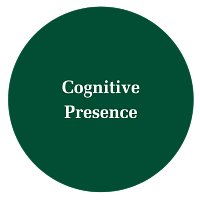
Garrison (2017) identifies four steps that should be employed in the classroom to foster Cognitive Presence. These steps mirror the steps of critical thinking and include:
- Triggering Event: A problem or dilemma is presented to the students, specifically one that would pique their interest.
- Exploration: Students attempt to figure out the nature of the problem.
- Integration: The information obtained during the exploration phase is given order and meaning.
- Resolution: Based on the work completed during the integration phase, a solution is selected. Students may need guidance to move toward the resolution phase, as they may tend to get entangled in the exploration and/or integration phases.
Instructors can go one step further by monitoring and regulating students’ learning when needed. Paz and Pereira (2015) note several areas where instructors can help regulate learning:
- Confirming understanding of tasks
- Assessing learning strategies and work processes and/or proposing corrections to those processes
- Reminding others of tasks and encouraging them to focus on or contribute to tasks, resources, and activities
- Helping with tasks, processes, or products of learning
- Managing the movement through learning phases or tasks
- Simple Steps Toward Achieving Cognitive Presence (click to expand)
Garrison (2017) provides a number of recommendations that can enhance Cognitive Presence:
High-Impact Practices
- Use problem- or project-based learning strategies. Avoid overwhelming students with information and/or assignments
- Target content and activities to provide concise background, direction, and structure for students to free up more time for the thinking process. Allow time for reflection individually and within the group.
- Coined by Garrison (2017), "shared metacognition" requires students to monitor and manage their understanding while also assisting others in their learning.
- Target content and activities to provide concise background, direction, and structure for students to free up more time for the thinking process. Allow time for reflection individually and within the group.
- Provide opportunities for students to replicate and reflect on the inquiry process
Discussion Support
- Create smaller discussion groups to help students process and form connections with course content more easily
- Within discussion boards use the following strategies:
- Provide stimulating prompts or questions
- Identify challenging issues that arise in discussions and guide students to focus on those
- Encourage learners to delve deeper into their thought processes by respectfully challenging their ideas
- Have students test their ideas by putting them into practice. Consider using an if/then approach:
- “If you believe x, then y is what it looks like in practice”
- Use problem- or project-based learning strategies. Avoid overwhelming students with information and/or assignments
- Cognitive Presence in Your Courses - Questions for Consideration (click to expand)
Content
- Do course learning objectives encourage higher-order thinking?
- How do you select content to support your objectives?
- Are course assignment and discussion prompts thoughtful and intentional?
- How do you focus student efforts in your courses?
- Do your learning materials and activities reflect the diversity of your learners?
- Do you incorporate inclusive images and a variety of voices/perspectives?
- Are your learning activities culturally responsive?
Collaboration
- Where in the course do opportunities emerge for students to collaborate and problem solve? Is there a focus on processing knowledge over producing an outcome? Is there room for students to test concepts and make errors?
- Is learning scaffolded?
- Are there places to provide formative feedback?
- Is there room for students to provide iteration and show growth?
- Do students interact together through peer-review?
- If so, is there a rubric to help guide the review and feedback process?
- Is feedback constructive, motivating, and actionable?
- Do course learning objectives encourage higher-order thinking?
References
Community of Inquiry
- Akyol, Z., & Garrison, D. R. (2008). The development of a community of inquiry over time in an online course: Understanding the progression and integration of social, cognitive and teaching presence. Journal of Asynchronous Learning Networks, 12(3-4), 3-22.
- Arbaugh, J. B. (2008). Does the community of inquiry framework predict outcomes in online MBA courses? International Review of Research in Open and Distributed Learning, 9(2), 1–21.
- Boston, W., Díaz, S. R., Gibson, A. M., Ice, P., Richardson, J., & Swan, K. (2010). An exploration of the relationship between indicators of the community of inquiry framework and retention in online programs. Journal of Asynchronous Learning Networks JALN, 14(1), 3-.
- Garrison, D. R. (2017). E-learning in the 21st century: a framework for research and practice. Routledge Falmer.
- Garrison, D. R., Anderson, T., & Archer, W. (2000). Critical inquiry in a text-based environment: Computer conferencing in higher education. The Internet and Higher Education, 2(2-3), 87-105.
- Garrison, D. R., & Arbaugh, J. B. (2007). Researching the community of inquiry framework: Review, issues, and future directions. The Internet and Higher Education, 10(3), 157-172.
- Garrison, D. R., Cleveland-Innes, M., & Fung, T.S. (2010). Exploring causal relationships among teaching, cognitive, and social presence: Student perceptions of the community of inquiry framework. The Internet and Higher Education, 13(1), 31-36.
- Kucuk, S., & Richardson, J. C. (2019). A structural equation model of predictors of online learners’ engagement and satisfaction. Online Learning (Newburyport, Mass.), 23(2), 196-.
- Paz, João, & Pereira, Alda. (2015). Regulation of learning as distributed teaching presence in the community of inquiry framework. TCC Worldwide Online Conference. Universidade Aberta, Lisboa, Portugal.


